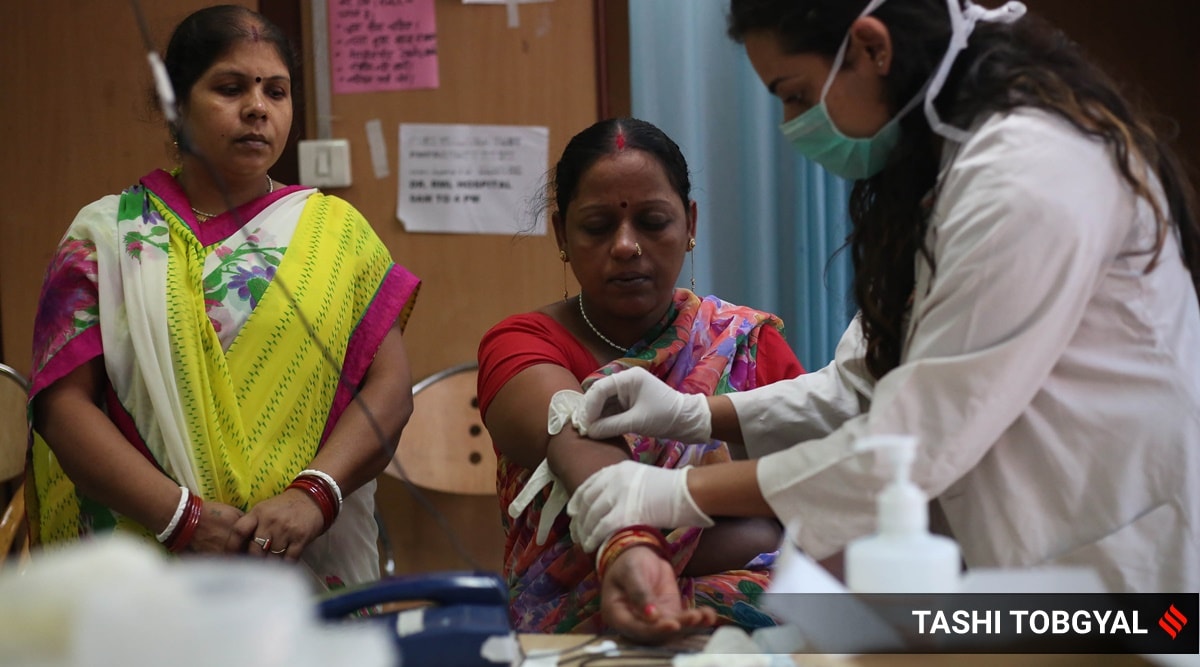 Patients with fever and symptoms of Dengue at the Fever Clinic in the RML hospital in the capital in New Delhi. (Express Photo by Tashi Tobgyal)
Patients with fever and symptoms of Dengue at the Fever Clinic in the RML hospital in the capital in New Delhi. (Express Photo by Tashi Tobgyal) COVID-19 pandemic has disrupted malaria services globally, leading to a marked increase in cases and deaths from the disease, new data from the World Health Organization (WHO) has revealed.
According to WHO’s latest World Malaria Report, an estimated 241 million malaria cases and 6,27,000 malaria deaths took place worldwide in 2020. This represents about 14 million more cases as compared to 2019, and 69,000 more deaths. Approximately, two-thirds of these additional deaths (47,000) were linked to disruptions in the provision of malaria prevention, diagnosis and treatment during the pandemic, according to the report.
Sub-Saharan Africa continues to carry the heaviest malaria burden, accounting for about 95% of all cases and 96% of deaths in 2020. About 80% of deaths in the region were among children under 5 years of age.
Notably, the pandemic struck at a point when global progress against malaria had already plateaued. By around 2017, there were signs that the phenomenal gains made since 2000, including a 27% reduction in global malaria case incidence and a nearly 51% reduction in the malaria mortality rate, were stalling.
Since 2015, the baseline date for WHO’s global malaria strategy, 24 countries have registered increase in malaria deaths. In the 11 countries that carry the highest burden of malaria worldwide, cases increased from 150 million in 2015 to 163 million in 2020 while deaths increased from 3,90,000 to 4,44,600 over the same period.
To get back on track, WHO and its partners recognise the need to ensure better and more equitable access to all health services, including malaria prevention, diagnosis and treatment, by strengthening primary health care and stepping up both domestic and international investments.
Scientist Dr V S Chauhan, known for his contribution to the development of a recombinant vaccine for malaria, said although dealing with COVID pandemic will remain a major concern, it is important to re-focus attention on malaria so that gains achieved over decades of hard work are not lost. “Otherwise, malaria will again become a huge health problem, particularly when the Artemisinin-resistant strains have already been detected in Africa. Effective surveillance, early detection and treatment of malaria, and increased efforts in vaccine and drug development are the need of the hour,” he said.
“COVID-19 pandemic has not only had a direct impact on human health and economies worldwide but has also seriously diverted attention from other major killer infectious diseases like malaria and tuberculosis. As suggested by the World Malaria Report, it is unfortunate and disturbing that both the number of cases as well as the number of deaths has significantly gone up,” he added.
According to the WHO report, 15 countries with a high burden of malaria reported reductions in malaria testing by more than 20% in April-June 2020 compared to the same period in 2019. National Malaria Programmes distributed about 48 million fewer courses of treatment in 2020 compared to the previous year. And, of the world’s 11 countries with the highest burden, only India registered progress against malaria. The 10 other countries, all in Africa, reported increase in cases and deaths.
In 2020, the global malaria case incidence rate was 59 cases per 1,000 people at risk against a target of 35 — putting it off track by 40%. The global mortality rate was 15.3 deaths per 1,00, 000 people at risk against a target of 8.9 — putting it off track by 44%. Reaching the 2030 goals of the WHO malaria strategy, including a 90% reduction in global malaria incidence and mortality rates, will require new approaches, new tools and better implementation of existing ones, experts said
- The Indian Express website has been rated GREEN for its credibility and trustworthiness by Newsguard, a global service that rates news sources for their journalistic standards.

